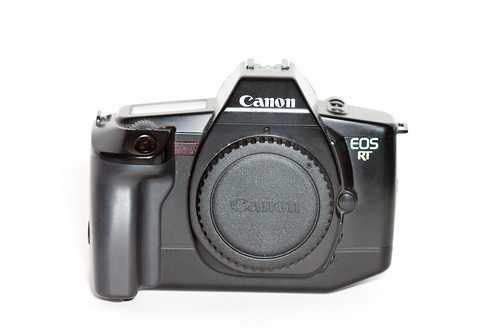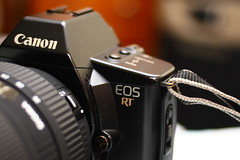Canon EOS RT

|
| image by tsy87 (Image rights) |
The Canon EOS RT is a member of the Canon EOS system of autofocus SLR cameras introduced in the late 1980s as a replacement of the T series manual focus SLRs. The RT is basically the EOS 600 (also sold in some markets as the EOS 630) body but fitted with a pellicle mirror instead of a conventional one and also coming with a few extra features.
A pellicle mirror is a fixed mirror which acts as a beam splitter, diverting part of the light that hits it up into the viewfinder and allowing the rest of the light to continue through the mirror and reach the shutter behind it. On the RT the pellicle allows approximately 2/3 of the light to reach the shutter and sends the other 1/3 up into the viewfinder.
The advantages of a pellicle mirror are that there is no vibration from the mirror moving up and down, giving potentially sharper images if correct technique is used, allowing faster shutter cycle times in continuous shooting mode, and giving an uninterupted image in the viewfinder as the photograph is taken unlike a conventional mirror which blacks out the viewfinder while the shutter operates.
The disadvantages are the fragility of a pellicle mirror which is often overstressed, the fact that if scratched or dirty then it can degrade the image as it remains in the light path as the image is captured, and the loss of the light that is directed into the viewfinder (approx 2/3 stop in an RT) and of course the viewfinder image is a bit darker than a conventional SLR.
The pellicle mirror was first used by Canon in the Pellix of 1965 as it allowed TTL metering by a cds cell which swung into the light path when the stop down/metering lever was depressed. The concept was revisited in the F-1 High Speed which was capable of 14 frames per second, and then brought back for the RT. It was later used in the EOS 1nRS which could shoot at 10 frames per second. Now with incresed advances in camera technology 10 frames per second is possible using a conventional mirror, so the pellicle has fallen from favour.
The RT in the name stands for "Real Time" and in RT mode when the shutter is partially depressed the camera readies itself and will respond by opening the first shutter curtain 8 milliseconds after the shutter button is fully depressed. In standard mode the shutter lag is 100 milliseconds, the same as other conventional SLRs in the range.
The RT can also fire 5 frames per second in continuous mode which was pretty good in 1989.

|
| image by 今 ゆっくりと 歩いていこう (Image rights) |
The EOS RT was introduced in October 1989 and featured advances specifications for its time. Focus modes include AI servo mode, where it will continuously refocus on a moving target. The shutter operates from 30 seconds to 1/2000 with B mode, and it will flash sync at 1/125 with the hot shoe, which interfaces with Canon Speedlite flash units to include ttl flash metering, and the flash will adjust for the focal length of the lens fitted. The viewfinder provides 94% coverage and information about focus lock, shutter, aperture etc is displayed inside the viewfinder. Metering is evaluative or centre weighted, with a 6.5% spot meter function.
The EOS RT uses a 2CR5 battery. All-up weight without a lens is 660g